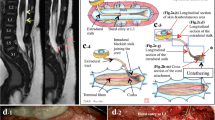Abstract
Purpose
Limited dorsal myeloschisis (LDM) is characterized by a fibroneural stalk linking the skin lesion to the underlying spinal cord. On account of the external skin lesion, all LDMs are either flat (nonsaccular) or saccular, and a human tail-like cutaneous appendage has not been reported.
Methods
In our 14 LDM patients, 2 had tail-like appendages. We retrospectively analyzed the relationship between the appendage and the LDM tract from the clinicopathological findings of these 2 patients.
Results
Preoperative magnetic resonance imaging including three-dimensional heavily T2-weighted images demonstrated an intradural tethering tract, but failed to reveal the precise communication with the appendage. However, surgery revealed the extradural and intradural slender stalk, starting at the base of appendage and running through the myofascial defect. Histological examination demonstrated that there was a tight anatomical relationship between the fibroadipose tissue of the appendage and the fibrocollagenous LDM stalk.
Conclusion
When there is potential for an LDM stalk in patients with an appendage, a meticulous exploration of the stalk leading from an appendage is required. Clinicians should be aware of possible morphological variations of skin lesions associated with LDM.



Similar content being viewed by others
Change history
02 March 2019
The article was recently published, contained error. Author name “Nobutaka Mukai” should be “Nobutaka Mukae”. Given in this article is the correct name.
References
Dao AH, Netsky MG (1984) Human tails and pseudotails. Hum Pathol 15:449–453
Donovan DJ, Pedersen RC (2005) Human tail with noncontiguous intraspinal lipma and spinal cord tethering: case report and embryologic discussion. Pediatr Neurosurg 41:35–40
Gaskill SJ, Marlin AE (1989) Neuroectodermal appendages: the human tail explained. Pediatr Neurosci 15:95–99
Hiraoka A, Morioka T, Murakami N, Suzuki SO, Mizoguchi M (2018) Limited dorsal myeloschisis with no extradural stalk linking to a flat skin lesion: a case report. Childs Nerv Syst 34:2497–2501
Lee JY, Chong S, Choi YH, Phi JH, Cheon J-E, Kim S-K, Park SH, Kim I-O, Wang K-C (2017) Modification of surgical procedure for “probable” limited dorsal myeloschisis. J Neurosurg Pediatr 19:616–619
Lee JY, Park S-H, Chong S, Phi JH, Kim S-K, Cho B-K, Wang K-C (2019) Congenital dermal sinus and limited dorsal myeloschisis: “Spectrum disorders” of imcomplete dysjunction between cutaneous and neural ectoderms. Neurosurgery 84:428–434
Morioka T, Murakami N, Shimogawa T, Mukae N, Hashiguchi K, Suzuki SO, Iihara K (2017) Neurosurgical management and pathology of the lumbosacral lipomas with tethered cord. Neuropathology 37:385–392
Morioka T, Suzuki SO, Murakami N, Shimogawa T, Mukae N, Inoha S, Sasaguri T, Iihara K (2018) Neurosurgical pathology of limited dorsal myeloschisis. Childs Nerv Syst 34:293–303
Morioka T, Suzuki SO, Murakami N, Mukae N, Shimogawa T, Haruyama H, Kira R, Iihara K (2019) Surgical histopathology of limited dorsal myeloschisis with flat skin lesion. Childs Nerv Syst 35:119–128
Murakami N, Morioka T, Hashiguchi K, Yoshiura T, Hiwatashi K, Suzuki SO, Nakamizo A, Amano T, Hata N, Sasaki T (2013) Usefulness of three-dimensional T1-weighted spoiled gradient-recalled echo and three-dimensional heavily T2-weighted images in preoperative evaluation of spinal dysraphism. Childs Nerv Syst 29:1905–1914
Pang D, Zovickian J, Oviedo A, Moes GS (2010) Limited dorsal myeloschisis: a distinctive clinicopathological entity. Neurosurgery 67:1555–1580
Pang D, Zovickian J, Wong S-T, Hou YJ, Moes GS (2013) Limited dorsal myeloschisis: a not-so-rare form of primary neurulation defect. Childs Nerv Syst 29:1459–1484
Samura K, Morioka T, Hashiguchi K, Yoshida F, Miyagi Y, Yoshiura T, Suzuki SO, Sasaki T (2009) Coexistence of a human tail and congenital dermal sinus associated with lumbosacral lipoma. Childs Nerv Syst 25:137–141
Tomita Y, Morioka T, Murakami N, Noguchi Y, Sato Y, Suzuki OS (2018) Slender stalk with combined features of saccular limited dorsal myeloschisis and congenital dermal sinus in a neonate. Pediatr Neurosurg. https://doi.org/10.1159/000495810
Tubbs RS, Malefant J, Loukas M, Oakes WJ, Oskouian RJ, Fries FN (2016) Enigmatic human tails: a review of their history, embryology, classification, and clinical manifestations. Clin Anat 29:430–438
Turk CC, Kara NN, Bacanli A (2016) The human tail: a simple appendage or cutaneous stigma of an anomaly? Turk Neurosurg 26:140–145
Wilkinson CC, Boylan AJ (2017) Proposed caudal appendage classification system; spinal cord tethering associated with sacrococcygeal eversion. Childs Nerv Syst 33:69–89
Acknowledgments
We thank Drs. Nobuko Kawamura, Ayumi Tsukamoto, and Ryutaro Kira for supporting our study. We also thank Edanz Group (www.edanzediting.com/ac) for editing a draft of this manuscript.
Funding
This work was partly supported by the Research Foundation of Fukuoka Children’s Hospital.
Author information
Authors and Affiliations
Corresponding author
Ethics declarations
Conflict of interest
The authors declare that they have no conflict of interest.
Additional information
Publisher’s note
Springer Nature remains neutral with regard to jurisdictional claims in published maps and institutional affiliations.
The original version of this article was revised: The article was recently published, contained error. Author name “Nobutaka Mukai” should be “Nobutaka Mukae”. Given in this article is the correct name.
Rights and permissions
About this article
Cite this article
Sarukawa, M., Morioka, T., Murakami, N. et al. Human tail-like cutaneous appendage with a contiguous stalk of limited dorsal myeloschisis. Childs Nerv Syst 35, 973–978 (2019). https://doi.org/10.1007/s00381-019-04071-w
Received:
Accepted:
Published:
Issue Date:
DOI: https://doi.org/10.1007/s00381-019-04071-w




